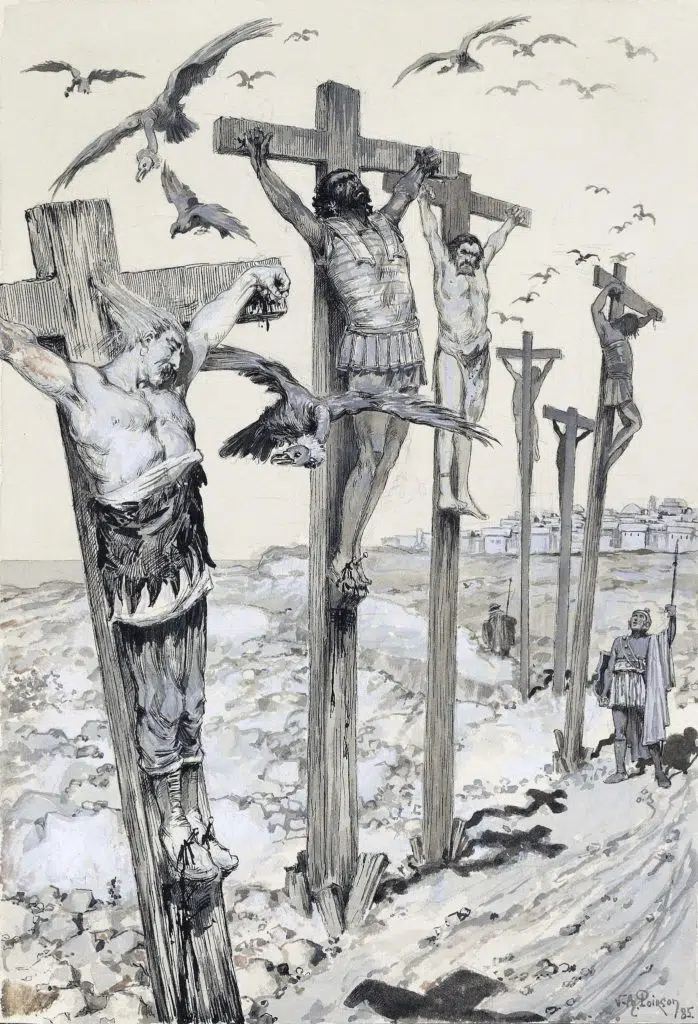
The form of execution known as crucifixion is most closely associated with Jesus Christ. It was the form of execution by which he was killed almost two thousand years ago. However, this method of killing someone long predates the Romans. Who really invented crucifixion?
What is crucifixion?
When most people hear the term ‘crucifixion,’ they tend to imagine a live person being nailed to a wooden cross. The person would remain there until they died of exposure, exhaustion, or suffocation. This is indeed the most famous version of it. However, other variations existed.
For example, sometimes, a person might be nailed to the cross after having been killed by other means. In this case, the crucifixion served a warning purpose to others rather than as a form of execution.
Another interesting point is that the cross was not always a cross. In fact, for both practical and logical purposes, the most common form of crucifixion was actually the use of a single stake. It was just as effective and was easier to set up.
The Roman writer Seneca mentions seeing numerous people being crucified. In his description, he mentions certain peculiar variations he witnessed. Among these was one in which victims had their arms stretched out on a crossbeam. Since he mentions this as a variation, we can assume it was not the standard form used by the Romans, which was evidently a single stake.
Early evidence from the Bible
Coincidently, not only does the Bible contain the single most famous crucifixion, but it also contains one of the very earliest references to a variation of it. In the Book of Deuteronomy, the detailed law code of the ancient Israelites contains a reference to a type of crucifixion: “If someone guilty of a capital offense is put to death and their body is exposed on a pole, you must not leave the body hanging on the pole overnight.”
This mentions a criminal being affixed to a pole or stake. Unlike the most famous form of crucifixion, this happened after the criminal was already put to death, as the text explains. Nonetheless, if we consider this to be a type of crucifixion, then this is perhaps the earliest reference to it in ancient literature.
The date of Deuteronomy is a subject of considerable debate among scholars. Moses is the traditional writer, placing its composition in the fifteenth century BCE. Other scholars date it later than this, but this would still be a very early reference.
Was crucifixion invented by the Persians?

Actually, this is not crucifixion in the common sense, that is, as a method of execution. Suspending a body to a stake or a cross after the person has already died is not what most people mean when they refer to crucifixion. Hence, in terms of an actual method of execution, who was the first to use this?
Many scholars claim the Persians invented crucifixion. However, the basis for this claim is weak. One piece of evidence comes from the Bible’s account of Esther in which Persian King Ahasuerus (Xerxes the Great) orders the death of one of his court officials around the year 484 BCE.
The problem is that Haman’s body is only placed on the large stake after he is executed through other means. This same issue also applies to another common piece of evidence. Herodotus refers to the Persians using crucifixion against their enemies in the era of their wars against the Greeks.
One example is the death of Polycrates of Samos. The Persian satrap Oroestes supposedly crucified him. In reality, it was only Polycrates’ lifeless corpse that Oroestes placed on a stake.
There are a variety of other texts in which Herodotus supposedly refers to the Persians using crucifixion, but the reality is that none of these are explicitly suspensions of a living victim affixed to a stake or cross. Many of them may have been suspensions of corpses or executions of living victims by impaling.
Who really invented crucifixion?
Of course, this does not mean that the Persians definitely did not use crucifixion. It is possible that they invented it. Nonetheless, the simple fact is that there is no clear evidence that this is the case. In reality, it appears that the earliest record of something which was unambiguously a crucifixion concerns the actions of the Greeks.
The record in question comes from Herodotus. Rather than his vague accounts of supposed Persian crucifixions, he is very explicit referring to what the Greeks did. He describes how the Athenians defeated the Persian general Artayctes in 479 BCE.
This general had plundered Greek territory and was responsible for a considerable amount of suffering in the area. For this reason, the Greeks despised him intensely. After they captured him and his son, the Athenians crucified him and stoned his son to death.
Herodotus leaves us no doubt about this. He specifically says that Artayctes was suspended to a board to which he was nailed. Thus, Herodotus is definitely describing crucifixion here. Therefore, it would appear that the Greeks (the Athenians, specifically) may well be the ones who invented crucifixion as a method of execution.
See all the latest news from Greece and the world at Greekreporter.com. Contact our newsroom to report an update or send your story, photos and videos. Follow GR on Google News and subscribe here to our daily email!



